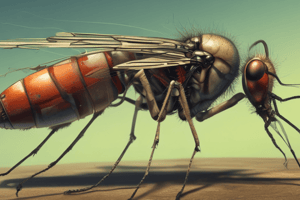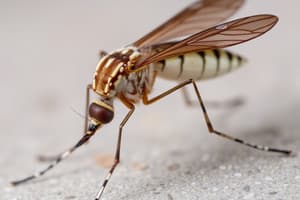Podcast
Questions and Answers
Which mosquito genus is known to be a vector for both Japanese encephalitis and filariasis?
Which mosquito genus is known to be a vector for both Japanese encephalitis and filariasis?
- Culex (correct)
- Aedes
- Mansonia
- Haemagogus
Which mosquito genus is known to predate on other insects?
Which mosquito genus is known to predate on other insects?
- Sabethes
- Aedes
- Coquillettidia
- Psophora (correct)
Which mosquito genus lays eggs in rafts on the water surface?
Which mosquito genus lays eggs in rafts on the water surface?
- Aedes
- Sabethes
- Culex (correct)
- Mansonia
Which mosquito genus is known to breed in tree holes and bamboo stumps?
Which mosquito genus is known to breed in tree holes and bamboo stumps?
Which mosquito genus is primarily active during the day and rests outdoors?
Which mosquito genus is primarily active during the day and rests outdoors?
Which mosquito genus is a major vector for dengue fever?
Which mosquito genus is a major vector for dengue fever?
Which of the following is NOT a control strategy used for Aedes mosquitoes?
Which of the following is NOT a control strategy used for Aedes mosquitoes?
Which mosquito genus is known for its distinctive black and white patterns on its thorax, legs, and abdomen?
Which mosquito genus is known for its distinctive black and white patterns on its thorax, legs, and abdomen?
Which mosquito genus is found mainly in tropical regions and is known to attach its larvae to aquatic plants for breathing?
Which mosquito genus is found mainly in tropical regions and is known to attach its larvae to aquatic plants for breathing?
Which of the following is NOT a commonly used insecticide for controlling Culex mosquitoes?
Which of the following is NOT a commonly used insecticide for controlling Culex mosquitoes?
Which of the following is NOT a major vector for filariasis?
Which of the following is NOT a major vector for filariasis?
Which mosquito genus is the main vector for onchocerciasis (river blindness) in Africa?
Which mosquito genus is the main vector for onchocerciasis (river blindness) in Africa?
Which of the following is a control strategy for Mansonia mosquitos?
Which of the following is a control strategy for Mansonia mosquitos?
Which of the following is NOT a form of filariasis?
Which of the following is NOT a form of filariasis?
Which of the following is an example of a larvicide used for controlling mosquito populations?
Which of the following is an example of a larvicide used for controlling mosquito populations?
What is the primary reason why males have larger lenses in the upper half of their eyes?
What is the primary reason why males have larger lenses in the upper half of their eyes?
Which of these is NOT a characteristic of black fly larvae?
Which of these is NOT a characteristic of black fly larvae?
What is the most common method used by black flies to deposit their eggs?
What is the most common method used by black flies to deposit their eggs?
Which one of these is NOT a feature of the black fly's wing structure?
Which one of these is NOT a feature of the black fly's wing structure?
What is the primary distinguishing characteristic of a black fly's tarsi (feet)?
What is the primary distinguishing characteristic of a black fly's tarsi (feet)?
What is the most common symptom of onchocerciasis (river blindness) in the skin?
What is the most common symptom of onchocerciasis (river blindness) in the skin?
How are black flies primarily controlled at the community level?
How are black flies primarily controlled at the community level?
Which of the following is a commonly used insecticide for controlling black fly larvae?
Which of the following is a commonly used insecticide for controlling black fly larvae?
Which of these plays a significant role in the transmission cycle of onchocerciasis?
Which of these plays a significant role in the transmission cycle of onchocerciasis?
What is the primary method used to treat onchocerciasis?
What is the primary method used to treat onchocerciasis?
Flashcards
Holoptic Eyes
Holoptic Eyes
Eyes that touch each other, commonly seen in males.
Short Antennae
Short Antennae
Males have short, 11-segmented, cylindrical antennae.
Biting Mechanism
Biting Mechanism
Labrum stretches skin; mandibles scrape and rupture capillaries.
Black Fly Eggs
Black Fly Eggs
Signup and view all the flashcards
Larvae Habitat
Larvae Habitat
Signup and view all the flashcards
Onchocerciasis
Onchocerciasis
Signup and view all the flashcards
Transmission Cycle
Transmission Cycle
Signup and view all the flashcards
Preventive Measures
Preventive Measures
Signup and view all the flashcards
Community Control
Community Control
Signup and view all the flashcards
Mass Drug Administration (MDA)
Mass Drug Administration (MDA)
Signup and view all the flashcards
Culicinae mosquitoes
Culicinae mosquitoes
Signup and view all the flashcards
Culex mosquitoes
Culex mosquitoes
Signup and view all the flashcards
Aedes mosquitoes
Aedes mosquitoes
Signup and view all the flashcards
Haemagogus mosquitoes
Haemagogus mosquitoes
Signup and view all the flashcards
Sabethes mosquitoes
Sabethes mosquitoes
Signup and view all the flashcards
Mansonia mosquitoes
Mansonia mosquitoes
Signup and view all the flashcards
Coquillettidia mosquitoes
Coquillettidia mosquitoes
Signup and view all the flashcards
psophora mosquitoes
psophora mosquitoes
Signup and view all the flashcards
Yellow fever
Yellow fever
Signup and view all the flashcards
Dengue
Dengue
Signup and view all the flashcards
West Nile virus
West Nile virus
Signup and view all the flashcards
Filariasis
Filariasis
Signup and view all the flashcards
Culex control methods
Culex control methods
Signup and view all the flashcards
Aedes control strategies
Aedes control strategies
Signup and view all the flashcards
Control of filariasis
Control of filariasis
Signup and view all the flashcards
Study Notes
Culicinae Mosquitoes
- Subfamily contains 40 genera
- Important genera include Culex, Aedes, Haemagogus, Sabethes, Mansonia (medically significant). Others include Coquillettidia, Psorophora (less significant).
- Many are disease vectors, including yellow fever, dengue, filariasis, and arboviruses.
Culex Mosquitoes
- Found worldwide except extreme northern regions.
- Lay eggs in rafts (300 eggs) on water surfaces.
- Larvae have a long siphon with multiple subventral hair tufts.
- Adults have brown scales, simple tarsal claws, and a blunt abdomen tip.
- Breed in polluted water (drains, septic tanks, ditches).
- Vector of filariasis (Wuchereria bancrofti, Japanese encephalitis).
- Bites at night (nocturnal) and rests indoors/outdoors.
Aedes Mosquitoes
- Found worldwide, including arctic regions.
- Lay black eggs singly on damp surfaces (can withstand drying).
- Larvae have short siphons and one subventral hair tuft.
- Adults have distinctive black and white patterns on thorax, legs, and abdomen.
- Breed in container habitats (tree holes, tires, pots, water storage).
- Vector of yellow fever, dengue, chikungunya.
- Bites during the day and rests outdoors.
Haemagogus Mosquitoes
- Found in Central and South America.
- Breed in tree holes and bamboo stumps.
- Bites during the day, mostly in treetops.
- Vector of yellow fever.
Sabethes Mosquitoes
- Found in Central and South America.
- Breed in tree holes, bamboo, bromeliads.
- Bites during the day, mainly in the canopy.
- Vector of yellow fever.
Mansonia Mosquitoes
- Found mainly in tropical regions.
- Lay eggs under floating vegetation.
- Larvae attach to aquatic plants to breathe.
- Breed in swamps, marshes, ponds.
- Bites at night and rests outdoors.
- Vector of Brugia malayi filariasis.
Coquillettidia Mosquitoes
- Found mainly in tropical and some temperate regions.
- Larvae attach to plants (similar to Mansonia).
- Vector of Brugia malayi filariasis.
Psorophora Mosquitoes
- Found mainly in North, Central, and South America.
- Breed in flooded pastures and rice fields.
- Some species are predatory.
- Not major disease vectors but aggressive biters.
Medical Importance of Culicinae Mosquitoes
- Many cause severe biting in tropical and temperate regions.
- Large-scale control operations exist to reduce nuisance.
Yellow Fever
- Regions: Africa and tropical Americas.
- Transmission:
- Sylvatic (forest): Monkey-to-monkey via Aedes africanus.
- Rural (edge of forest): Monkey and human via Aedes bromelia, Aedes luteoceohalus.
- Urban (cities): Human-to-human via Aedes aegypti.
- Vectors: Aedes (Africa, Americas), Haemagogus, and Sabethes (Americas).
- Control: Vaccination (17D mosquito).
Dengue
- Regions: Worldwide (50 million cases/year).
- Vectors: Aedes aegypti, Aedes albopictus.
- Transmission: Human-to-human (no animal reservoir).
- Types: Dengue fever, dengue hemorrhagic fever (severe).
- Control: Larval habitat reduction, genetic control (sterile male releases).
West Nile Virus
- Regions: Africa, Middle East, Europe, Americas.
- Vectors: Culex pipiens, Culex quinquefasciatus, Culex tarsalis.
- Hosts: Birds (primary reservoir), human & horses (dead-end hosts).
- Control: Mosquito reduction.
Japanese Encephalitis
- Regions: Asia, Papua New Guinea.
- Vectors: Culex tritaeniorhynchus, Culex vishnui (breed in rice fields).
- Hosts: Birds (primary), pigs (amplifying), humans (dead-end).
- Control: Vaccination, vector control.
Chikungunya
- Regions: Africa, Asia, Indian Ocean, Europe.
- Vectors: Aedes aegypti, Aedes albopictus.
- Hosts: Monkeys in Africa (possible zoonotic transmission).
- Control: Mosquito habitat reduction.
Filariasis
- Vectors: Culex, Aedes, Mansonia, mosquitoes.
- Forms:
- Bancroftian filariasis (W. bancrofti): No animal reservoir.
- Brugian filariasis (B. malayi): Reservoirs include monkeys, cats.
- Periodic Forms: Nocturnally periodic (Culex quinquefasciatus, Anopheles), Diurnally subperiodic (Aedes polynesiensis).
- Control: Mass drug administration (MDA), bed nets, vector control.
Control Strategies for Culicine Mosquitoes
- Aedes Control: Source reduction (eliminate breeding sites), larvicides (temphos, methoprene, Bacillus thuringiensis israelensis (Bti)), genetic control (sterile male release), vaccination (yellow fever).
- Culex Control: Sanitation improvements, insecticides (temephos, methoprene, chlorpyrifos), expanded polystyrene beads in pit latrines.
- Mansonia Control: Weed removal/herbicides to eliminate aquatic plants, granular insecticides for larval control.
- Filariasis Control: Mass drug administration (albendazole + ivermectin), insecticide-treated bed nets (ITNs), WHO's global program to eliminate lymphatic filariasis.
Black Flies (Simuliidae)
- Family: Simuliidae
- Found worldwide with >200 species in 25 genera.
- Medically important genus: Simulium
- Other genera: Prosimulium, Austrosimulium
Main Disease: Onchocerciasis (River Blindness)
- Vector:
- Africa: Simulium damnosum complex, Simulium neavei
- Central & South America: Simulium ochraceum, Simulium metallicum, Simulium exiguum
- Other transmissions: Simulium amazonicum (Mansonella ozzardi - filarial parasite, usually non-pathogenic).
General Characteristics
- Small (1.5–4 mm).
- Usually black, but some species have other colors/patterns.
- Humped thorax.
Head Features
- Females: Dichoptic eyes.
- Males: Holoptic eyes (touching).
- Males have larger upper eye lenses.
- Short, 11-segmented antennae.
- Short, inconspicuous mouthparts with hanging maxillary palps.
Biting Mechanism
- Labrum stretches skin.
- Mandibles and maxillae scrape and rupture blood capillaries.
- Blood is sucked up.
Wing Features
- Short, broad wings with few veins.
- No scales or prominent hairs.
- Colorless or nearly so.
- Wings rest over body like closed scissors.
Legs and Abdomen
- Legs with fine hairs, possible bands.
- Tarsi with simple claws.
- Short, squat abdomen with fine hairs.
Life Cycle of Black Flies
- Eggs: Triangular, black or brown, laid in flowing water.
- (Simulium ochraceum): Eggs scattered across water.
- Larvae: Cylindrical, swollen abdomen, attach to surfaces in flowing water.
- Pupae: Attached to underwater surfaces in cocoons.
- Adults: Emerge from pupae, fly long distances, lifespan several weeks.
Onchocerciasis Transmission
- Infected black fly bites human --> injects L3 filarial larvae.
- Larvae mature, form skin nodules.
- Adult worms produce microfilariae migrating through skin.
- Black fly bites infected person, ingests microfilariae.
- Microfilariae mature into infective L3 larvae inside fly, cycle repeats.
Onchocerciasis Symptoms
- Severe itching, skin thickening.
- Depigmentation.
- Eye infection and blindness.
Onchocerciasis Prevention
- Vector control (reducing black fly populations).
- Mass drug administration (MDA) with Ivermectin.
Control of Black Flies
- Personal Protection: Insect repellents, protective clothing, avoiding infested areas during peak biting times.
- Community-Level Control: Reducing breeding sites (removing vegetation, modifying water flow), larvicides (Bti), and MDA with Ivermectin.
Studying That Suits You
Use AI to generate personalized quizzes and flashcards to suit your learning preferences.


